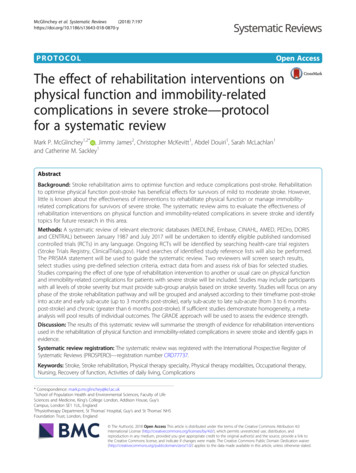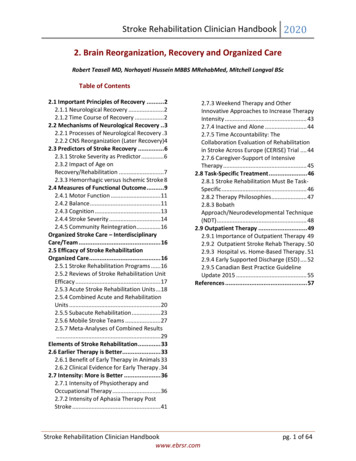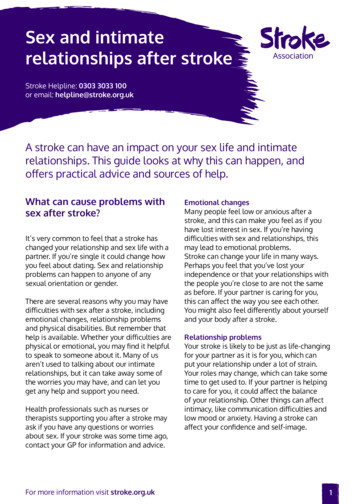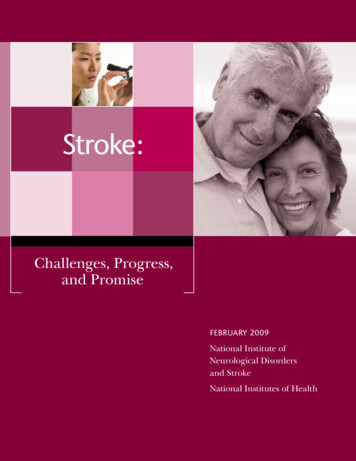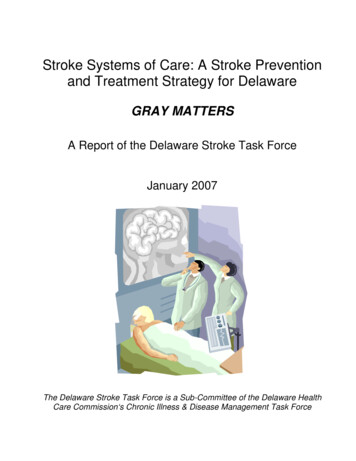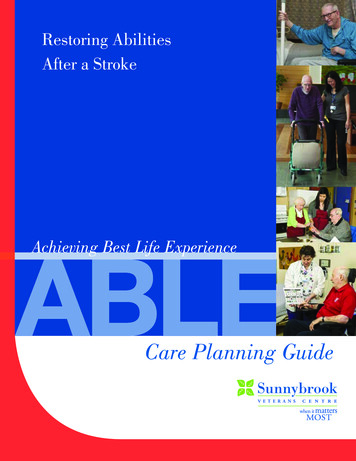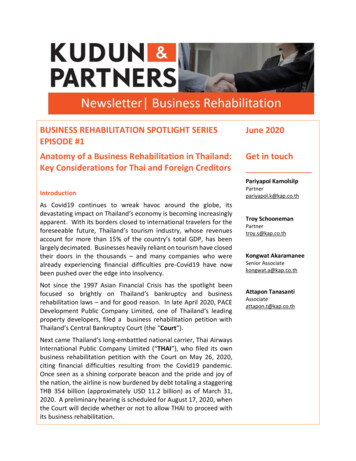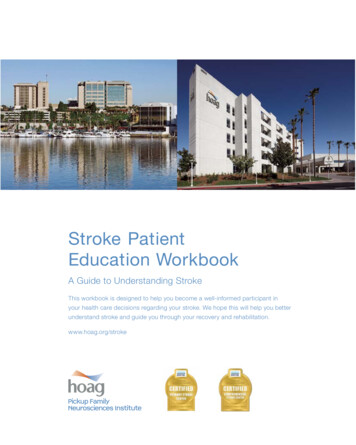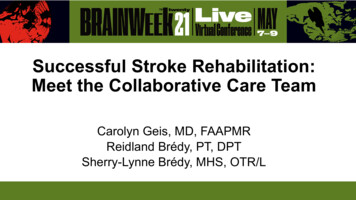
Transcription
Successful Stroke Rehabilitation:Meet the Collaborative Care TeamCarolyn Geis, MD, FAAPMRReidland Brédy, PT, DPTSherry-Lynne Brédy, MHS, OTR/L
Title & Affiliation Carolyn Geis, MD, FAAPMR
Title & Affiliation Reidland Bredy, PT, DPT Staff neurological therapist at UF Health Magnolia Parke in Gainesville,FL
Title & Affiliation Sherry-Lynne Bredy, MHS, OTR/L Staff neurological therapist at the Fixel Institute for NeurologicalDisorders in Gainesville, FL
Disclosure No financial disclosures to list
Learning Objectives Understand the structure of the stroke rehabilitation team Establish a general understanding of the roles of each memberof the stroke rehabilitation team Discuss the roles of the stroke rehabilitation team with specificfunctional deficits Present case studies with a look at how the stroke rehabilitationteam would function Discuss typical goals of the stroke rehabilitation team for thecase studies presented
Overview of Stroke Rehabilitation Patient Focused Patient Specific Comprehensive Multidisciplinary Interdisciplinary Patient and team based
Stroke Rehabilitation Team and sychologyPatient and ySpeechTherapyPhysicalTherapyOccupationalTherapy
Team approach to Stroke Rehabilitation Each team member brings theirindividual expertise to care of thepatient but functions in collaborationwith other team members Goal setting is best done as a teamand goals are regularly updated Communication among the team iscritical to developing tactics to achievegoals and to identify barriers to patientprogress
Stroke Rehabilitation CollaborationOpportunities Many areas of function areaffected after stroke andrequire the expertise of thewhole rehab team We will investigate 2examples: Eating Toileting
Eating after Stroke: Team membersinvolved Medical Nursing Speech Therapy Dietician Occupational Therapy Physical Therapy Psychology Case manager
Eating after stroke: Roles andCollaboration Medical Aspiration/pneumoniaprevention Hydration Nutrition/Weight Nursing Positioning upright Management of supplementalfeeding
Eating after stroke: Roles andCollaboration Speech Evaluation of dysphagia (swallowing) Assess appropriate food/liquidconsistencies Educate and train in appropriatechewing and swallowing strategies Caregiver education Dietician Evaluation for supplemental feedingand hydration Monitoring of hydration and nutritionalparameters
Eating after Stroke: Roles andCollaboration Occupational Therapy Training motor planning and coordination forfeeding Set up feeding environment Training in adaptive utensils and equipment Assessing and training in functionalcognition and safety awareness Caregiver training Addressing role changes and feedingroutines Physical Therapy Positional stabilityBalanceSitting toleranceRange of motion
Eating after Stroke: Roles andCollaboration Psychology Depression Anxiety Changing roles infamily/caregiver Case management Resources for appropriate diet Caregiver resources Support groups
CASE 1Grace is a 67 year old female who is a manager of a popular restaurant in town.She went to work early one morning to prepare for one of the busiest days of theweek when she experienced sudden right side weakness in her hand dropping herkeys and weakness in her right foot tripping into her office. She fumbled for herphone to call her husband, when he answered her speech was slurred and hecouldn’t understand her. He called her with video and noted the facial droop on herface and immediately called 911.Her past medical history includes chronic hypertension and she is a type 2 diabetic.She has a family history of hypertension and strokes. Grace lives with her husbandand near her two grown children, waiting for the soon arrival of her 3rd grandchild.Grace is a natural worrier and works in a very stressful job. She loves it and wasnot planning on retiring just yet.
CASE 1 ContinuedAt the hospital she presented with initial symptoms of right sidedweakness, slurred speech and right side facial droop. She alsoexhibits aphasia and dysarthria upon further assessment. Her bloodpressure was 167/98. Her MRI scan showed a MCA ischemic strokeon the left parietal lobe. tPA was administered since she arrivedwithin an hour from the onset of symptoms. She was admitted to thehospital in acute care for 3 days then transferred to in-patient rehabwhere she received a multi-disciplinary approach to rehabilitationwhile being monitored by physical medicine and the rehab nursingstaff.
Goal setting for CASE 1: Medical Nursing Speech therapy Dietician Occupational therapy Physical therapy Psychology Case management
Toileting after Stroke: Team membersinvolved Medical Nursing Occupational Therapy Physical Therapy Speech Therapy Case management
Toileting after Stroke: Roles andCollaboration Medical Neurogenic bladder Infection Medication review Nursing Catheter removal Toileting program
Toileting after Stroke: Roles andCollaboration Occupational therapy Setup and sequencing of toileting Clothing management and Hygiene Assessment and training of toiletingaids and devices Training in functional cognition andsafety Caregiver training Physical therapy TransfersStanding and sitting balanceWeight shiftingStrength and functional use ofinvolved limbs
Toileting after Stroke: Roles andCollaboration Speech therapy Training in communicatingneeds Psychology Changing roles and needs forassistance Case Management Resources for equipment Follow-up care
Goal setting for CASE 1 Examples of goal setting MedicalNursingOccupational therapyPhysical therapySpeech therapyPsychologyCase management
Falls Medical Medications Mental status Nursing Alert systems Transfers Speech Memory Call systems
Falls Occupational therapy Arrangement of physicalenvironment Safety Awareness techniques Addressing functional cognition Physical therapy Lower extremity strengthening Balance Floor transfer
CASE 2Jerry is a 75 y/o retired police officer who loves fishing. Recently he has had somenumbness in his left hand but didn’t think much of it until he realized he couldn’t tiea knot with the fishing line. He spent the day out fishing and as he was walkinghome his vision changed and things got blurry and fell unconscious. His worriedwife found him about 3 hours later and called 911.In the ED, Jerry had left side paralysis, numbness and tingling of his left side ofbody, he had homonymous hemianopsia, impaired memory, and demonstrated lackof insight to impairments which made him a high risk for falls in the hospital. Jerryhas a history of high cholesterol, high blood pressure, and history of heart disease.Jerry stayed in acute care for 5 days then transferred to inpatient rehab.
Goal Setting CASE 2 Medical Nursing Speech therapy Dietician Occupational therapy Physical therapy Psychology Case management
Conclusion The best examples of stroke rehabilitation teams bring togethera group of individuals each of whom have a unique expertisethat is blended with the expertise of other team members todeliver comprehensive interdisciplinary care to stroke survivors
References Winstein CJ, Stein J, Arena R, et al. Guidelines for AdultStroke Rehabilitation and Recovery: A Guideline forHealthcare Professionals From the American HeartAssociation/American Stroke Association. 4 May 2016 STR.0000000000000098
of the stroke rehabilitation team Discuss the roles of the stroke rehabilitation team with specific functional deficits Present case studies with a look at how the stroke rehabilitation team would function Discuss typical goals of the stroke re
